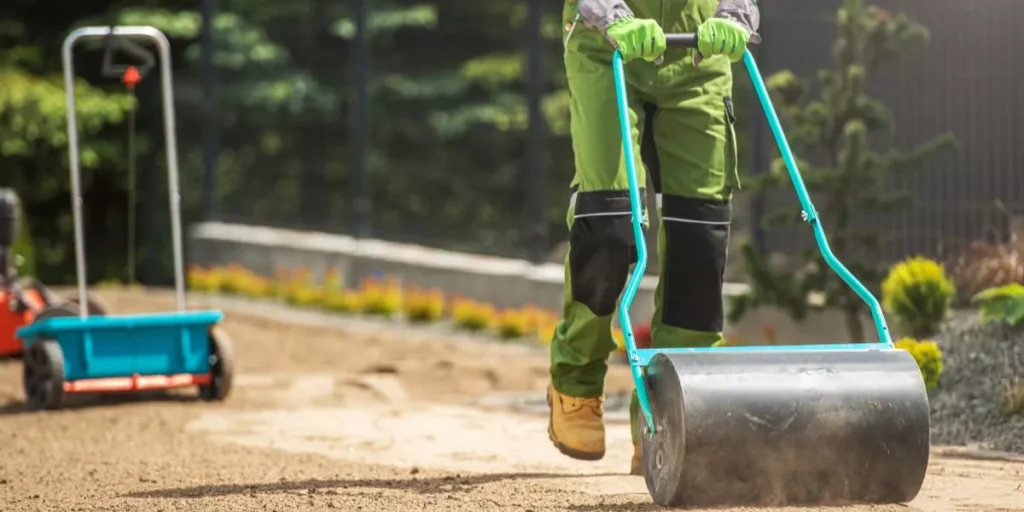
Maintaining proper soil structure in your lawn is crucial for healthy grass growth. By avoiding soil compaction, you ensure that essential nutrients, water, and air can reach the roots effectively. So, how do you go about preventing this issue? Well, it all starts with…
Understanding Soil Compaction
To truly grasp the impact of soil compaction on your lawn, consider the analogy of a tightly packed sponge unable to absorb water effectively. Just like the sponge, when soil becomes compacted, it loses its ability to take in essential nutrients, water, and air, which are vital for the health of your lawn.
Soil compaction occurs when the soil particles are pressed together, reducing pore spaces where roots thrive. This compression restricts root growth, leading to shallow roots that are more susceptible to stressors like drought and pests.
Compacted soil also hinders water infiltration, causing runoff and erosion issues. When water can’t penetrate the soil, it leads to puddling on the surface, creating a breeding ground for diseases and attracting unwanted pests. Additionally, compacted soil diminishes the soil’s microbial activity, essential for breaking down organic matter and enriching the soil with nutrients.
Understanding soil compaction is crucial for maintaining a healthy lawn. By recognizing the signs and causes of compaction, you can take proactive steps to prevent it and promote optimal growth for your grass.
Implementing Proper Lawn Maintenance
When it comes to maintaining a healthy lawn and preventing soil compaction, proper lawn maintenance practices play a key role in ensuring your grass thrives. Regular mowing is essential to keep your grass at the right height, typically around 2.5 to 3.5 inches, as this encourages strong root growth and prevents the soil from becoming too compacted.
Additionally, watering your lawn deeply but infrequently can help prevent compaction by encouraging roots to grow deeper into the soil in search of moisture.
Another crucial aspect of proper lawn maintenance is aerating your lawn at least once a year, ideally in the fall or spring. Aerating involves creating small holes in the soil to allow air, water, and nutrients to reach the grassroots more effectively, preventing compaction and promoting healthier grass growth.
Utilizing the Right Tools and Techniques
Properly selecting and employing the correct tools and techniques is essential for effectively preventing soil compaction in your lawn. When it comes to mowing your grass, make sure your lawnmower’s blades are sharp. Dull blades can tear the grass, leading to stress and making it more susceptible to compaction. Additionally, adjust the mowing height to ensure you aren’t cutting off more than one-third of the grass blade at a time. This helps maintain a healthy root system that can better withstand compaction.
Furthermore, consider aerating your lawn at least once a year, especially in high-traffic areas. Aerating helps reduce compaction by creating small holes in the soil, allowing air, water, and nutrients to penetrate deeper into the ground. Utilizing aeration tools such as core aerators or spike aerators can effectively alleviate compacted soil.
Lastly, when watering your lawn, use a soaker hose or drip irrigation system to deliver water directly to the roots. This targeted watering method encourages deep root growth, making the grass more resilient to compaction. By incorporating these tools and techniques into your lawn care routine, you can effectively prevent soil compaction and promote a healthy, thriving lawn.
Promoting Healthy Root Development
Promote strong and healthy root development in your lawn by incorporating targeted watering techniques and investing in appropriate aeration tools. Water your lawn deeply but infrequently to encourage roots to grow deeper into the soil. Shallow, frequent watering leads to shallow root systems, making your lawn more susceptible to stress and compaction. Aim for watering sessions that penetrate at least 6 inches into the soil to stimulate root growth.
Additionally, consider using core aerators to alleviate soil compaction and promote better air and water penetration. Core aeration removes small plugs of soil from your lawn, allowing roots to expand more freely and access essential nutrients. This process also enhances soil structure, fostering a healthier environment for root development.
Garden














